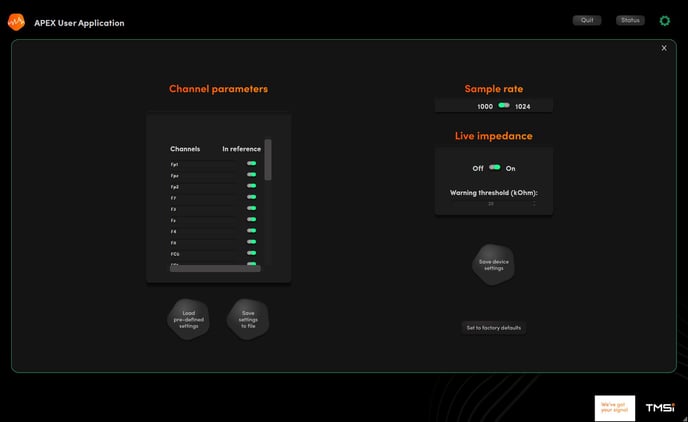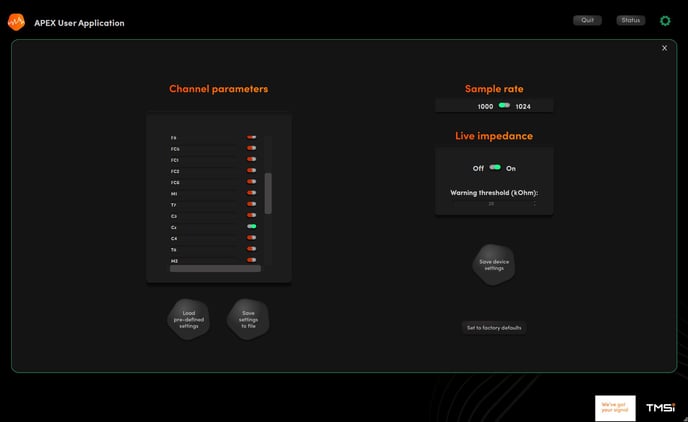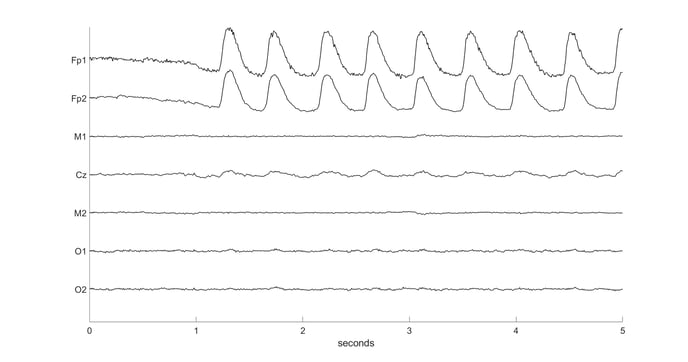The referencing method determines the EEG signal and how it is saved.
This article starts by explaining what referencing for EEG is. Afterwards, this article will show how referencing works in TMSi’s EEG amplifier, APEX, and how the type of referencing affects the EEG signal.
What is referencing?
An electrophysiological amplifier measures the difference in electrical activity between two points. In bipolar recordings, the signal is the result of the difference between two electrodes. Therefore, the electrical activity that is present at both electrodes is removed. This allows the amplifier to only amplify the voltage difference between the electrodes.
When measuring EEG, it is common that data is recorded from multiple electrodes, which is called a unipolar recording. In the case of a unipolar recording, the signal from one electrode, called the reference electrode, is used as a reference to find the difference with all other electrodes. This reference electrode can be separated further to either be one physical electrode or a calculated average of multiple electrodes.
Common reference
With a common reference, the reference electrode is a physical electrode on the cap itself. Frequently used common reference electrodes are positioned centrally on the headcap, such as the Cz position. When using a common reference, all electrodes will be amplified with respect to the chosen physical electrode.
Average reference
The average reference is constructed out of all ‘switched on’ electrodes of the headcap. So, all single electrodes are amplified with respect to the average of all recorded electrodes.
Multi-channel reference
It is also possible that a subset of electrodes is used as reference. In that case, every electrode is compared to the calculated average signal of this subset. Often, these are two electrodes such as the linked mastoids. Here, the electrodes on the mastoids of the left and right sides of the head (M1 and M2) are used.
NOTE
It is always important to connect the amplifier’s Patient Ground (PGND) electrode. This PGND electrode ensures a stable connection between body and amplifier and improves the rejection of common mode signals.
How does referencing work with APEX?
The default setup of APEX is that of an average reference amplifier. This means that each input is amplified against the average of all inputs. However, the applied reference method for the device is configurable. In APEX’s application software, an option is provided to include or exclude specific channels from the reference set. A selection of one or more electrodes can be made to be included in the reference.
How do I configure the reference in APEX’s user application?
The APEX User Application can be used to configure APEX and to show (and record) real-time signals. In this application, the reference channels can be configured using the following steps:
- Start the APEX User Application and connect to APEX via USB or Bluetooth.
- Click on settings on the main page.
- The channel parameters show a list of channels that are currently included (green) or excluded (red) in the reference. Select the channels that you would like to include as a reference. Below, two examples are shown. Figure 1 shows an average reference configuration and Figure 2 shows a configuration where the Cz electrode is used as common reference.

Figure 1: Average reference selected in the APEX User Application

Figure 2: Common reference (Cz) selected in the APEX User Application
How does the reference type affect the signal?
The type of reference affects how the EEG signal is shown in the viewer and is saved to a file. When interpreting the EEG signal, the researcher should be aware of the selected reference, as this can influence the interpretation. There is no ‘best’ reference method, as each method has its advantages and disadvantages.
When using one or two electrodes as reference, all signals are highly dependent on the connection quality of these electrodes. If the connection quality is poor, or if there is any form of interference on the reference electrode, such as muscle activity, then all channels are affected.
When using average referencing, the common part of the signal (for example mains interference noise) in all electrodes is suppressed as much as possible. However, large amplitude artifacts can that are only expected in a few channels, can be shown in all channels when using average referencing.
An example of this is a blinking artifact, shown in the signal recordings in the figures below. A blinking artifact would be expected to be observed in the (pre-) frontal channels. When Cz is used as common reference (Figure 3), the blinking artifact is seen only where it is expected, and not in the other channels. However, when using average referencing, as shown in Figure 4, the blinking artifact can also be recognized on other channels (showing with reversed polarity).

Figure 3: EEG signal using Cz as common reference with blinking artifact in Fp1 and Fp2 after one second.

Figure 4: EEG signal using average referencing with blinking artifact seen in all electrodes after approximately three seconds.
Conclusion
EEG data, obtained with TMSi amplifiers, represents a single electrode’s difference with the reference signal. The reference signal can be one single physical electrode or a calculated average of a couple or all electrodes. In APEX’s application software, you can select which electrodes should be included in the reference. This choice affects the signal that is shown in the signal viewer and saved to file.
Do you have further questions on this topic?
Contact ✉️ support@tmsi.com, 📞+31 (0)541 539 013 or 📄 request support.